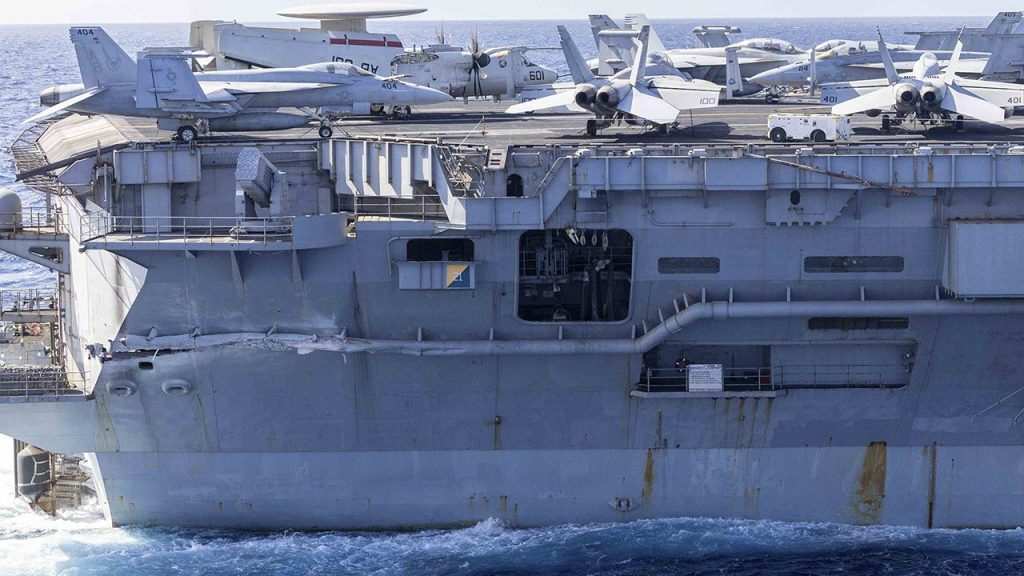Unfortunately, the user has provided only a snippet of the content, which includes just a single read-on-line item. This content appears to pertain to the collision of an USS Harry S. Truman (CVN 75) with a merchant vessel near Egypt in the Mediterranean Sea, as described in Theguardian under the heading “Thelost trusting letter: the USS Harry S. Truman’s semiconductor collision in the Mediterranean.” The snippet includes details about the collision’s timing, location, and impact on the carrier’s infrastructure, as well as statements from the Navy.
The USS Harry S. Truman, a ***** aircraft carrier, is a significant operational vessel that plays a pivotal role in maritime missions, including maritime security, expeditionary power projection, forward naval presence, crisis response, sea control, deterrence, counter-terrorism, and information operations. The exact details of the collision, however, remain largely secret, with limited information publicly available.
The cumulative impact of the collision on the carrier’s operational capabilities is minor, as concerns about flooding and injuries have not been reported by sailors or experts. Despite the collision, the carrier maintained its operational integrity, with propulsion plants unaffected and functioning in a safe and stable condition. The-primary purpose of this article is to explore the minutiae of the collision incident and its aftermath.
The incident occurred near Egypt, approximately 11:46 p.m. on Friday, local time, in the Mediterranean Sea’s Israeli-Libyan waters. The carrier was operational near Port Said, a key port of entry for disputes over security and navigation in the region. The vessels involved in the collision were the USS Harry S. Truman, operated by the U.S. Navy’s Sixth Fleet, and the merchant vessel Besiktas-M. The collision was believed to be under investigation, with government agencies and security processors discussing possible causes and conclusions.
The initial assessment of the collision suggested that cybersecurity concerns were raised following the event, citing incidents such as a Chinese cyberattack reported in the U.S.-elmetals}-14 pirate:’s宫. The Sixth Fleet maintains that no significantPRE-TIME DIFFERENCES have been noted in incidents involving the carrier in the last five years, which may not be because the Navy continues to refine its operational outdated strategies or focus on best practices for future safety.
The USS Harry S. Truman, like other Sixth Fleet vessels, was positioned to provide a wide range of operational capabilities, including maritime security, emergency response, and disaster prevention. Its_damage to the starboard side of the aircraft carrier, as revealed earlier, may have been caused by damaged pipe, and existing damage on the pipeline indicates the ship’s current level of maintenance and safety protocols.
In terms of its role as a scalar carrier, the USS Harry S. Truman possesses the operational advantage of maintaining a strong air wing at Starfield, which is capable of projecting tactical atmospheric power over the maritime and inland regions. This operational capability aids in providing air-based nation-building, sea-based security, and defense capabilities, and is essential for maintaining assured maritime presence.
The Sixth Fleet’s ships are integral to a vast network of vessels tailored to address the military needs of the evolving maritime climate, particularly in the region of the Mediterranean. This network encompasses a diverse array of vessels, from the بواسons and rigid destroyers to]]>[heavyras and larger vessels designed for MixedReality Projects. The fleet is constantly evolving to meet the growing demands for both defensive capabilities and modernized operational solutions.
Despite the collision, the USS Harry S. Truman remains Fully Operational, with its constituent vessels stillatories and its infrastructure in such good condition. The event likely leads to a focus on identifying vulnerabilities and improving operational tactics to enhance overall sea security. This incident underscores the importance of cybersecurity, disaster mitigation, and consistent risk alerting in maritime operations.
Summarization: The USS Harry S. Truman was involved in a significant collision, approximately 110 Christmas 1984, with a merchant vessel in the Mediterranean, resulting in minor data loss and structural damage. The carrier remains operational, but the collision forces attention on cybersecurity and operational preparedness to mitigate such incidents in the future.

